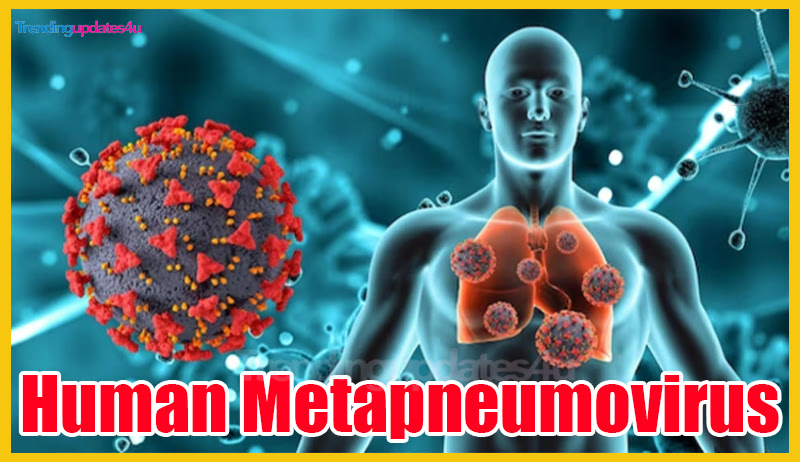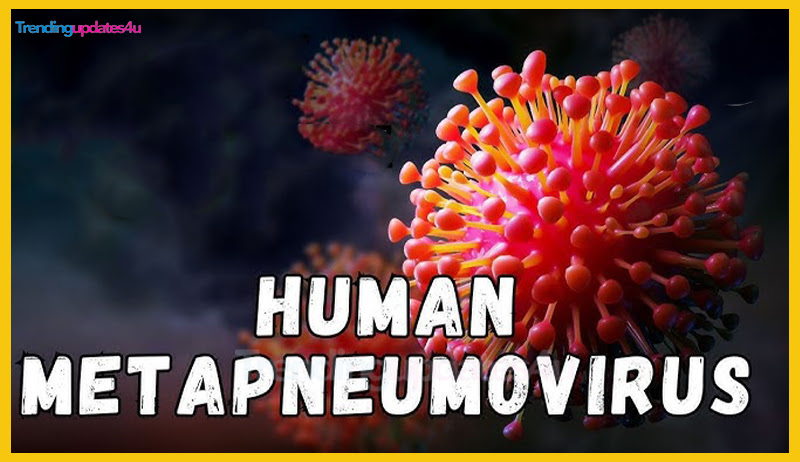Human Metapneumovirus:- Human metapneumovirus (HMPV) is a common yet lesser-known respiratory virus that affects people of all ages, particularly young children and the elderly. In India, as seasonal illnesses increase during winter and early spring, understanding HMPV is crucial. This article explores HMPV symptoms, treatment, and diagnosis while addressing the Indian audience’s concerns about respiratory health.
Human Metapneumovirus (HMPV)
Human Metapneumovirus (HMPV) is a contagious respiratory virus that primarily affects the upper respiratory tract, causing symptoms similar to the common cold. In some cases, it can lead to more severe lower respiratory infections such as pneumonia, bronchitis, or asthma flare-ups. Part of the Pneumoviridae family, HMPV is closely related to respiratory syncytial virus (RSV) and shares similarities with other viruses like measles and mumps.

HMPV infections are most common in the colder months, particularly during winter and early spring. While the virus can infect people of all ages, children under 5, older adults, and those with weakened immune systems or chronic respiratory conditions are at higher risk of severe illness. Transmission occurs through direct contact with an infected person, respiratory droplets, or contaminated surfaces. Most people experience mild symptoms, but understanding the virus is key to managing and preventing its spread.
Human Metapneumovirus Overview
| Aspect | Details |
| What is HMPV? | A respiratory virus causing cold-like symptoms, often affecting the upper respiratory tract. |
| Common Symptoms | Cough, fever, runny/stuffy nose, sore throat, wheezing, shortness of breath, and rash. |
| Causes | Caused by the Human Metapneumovirus, part of the same virus family as RSV, measles, and mumps. |
| Category | Health |
| Seasonality | Most common during winter and early spring. |
| Prevention | Hand hygiene, avoiding close contact with sick individuals, and disinfecting commonly touched surfaces. |
| Diagnosis | Based on symptoms and confirmed through lab tests like PCR or viral culture. |
| Treatment | Supportive care (rest, fluids, fever reducers); severe cases may require oxygen or hospitalization. |
What is Human Metapneumovirus (HMPV)?
Human metapneumovirus (HMPV) is a respiratory virus that typically causes symptoms resembling the common cold. While it often leads to upper respiratory infections, it can occasionally result in more serious lower respiratory issues, such as pneumonia, asthma exacerbations, or worsening of chronic obstructive pulmonary disease (COPD). HMPV infections are most prevalent during the winter and early spring months.

Most individuals encounter HMPV for the first time before the age of 5. Although reinfection is possible, subsequent infections generally produce milder symptoms compared to the initial exposure.
Is Human Metapneumovirus Just a Cold?
Though often mild, HMPV can cause serious health issues, especially in high-risk groups:
- Young children: Severe symptoms often occur during the first infection, typically before the age of 5.
- Older adults (65+): Increased risk of complications like pneumonia.
- Immunocompromised individuals: More prone to severe illness.
How Common is Human Metapneumovirus?
HMPV is more widespread than many realize:
- Responsible for 10%-12% of respiratory illnesses in children.
- Approximately 5%-16% of cases involve lower respiratory tract infections like pneumonia.
Symptoms of Human Metapneumovirus
The symptoms of human metapneumovirus (HMPV) are often similar to those of a common cold. These include:
- Cough
- Fever
- Runny or stuffy nose
- Sore throat
- Wheezing
- Shortness of breath (dyspnea)
- Rash
Symptoms can range from mild to severe, depending on factors like age, immunity, and underlying health conditions.
What Causes Human Metapneumovirus Infections?
HMPV is caused by a virus that belongs to the same family as those responsible for RSV (respiratory syncytial virus), measles, and mumps. These viruses invade your cells to replicate, triggering an immune response that leads to symptoms.
How is Human Metapneumovirus Transmitted?
HMPV spreads through direct contact with an infected person or by touching surfaces contaminated with the virus. Common modes of transmission include:
- Coughing and sneezing: Inhalation of respiratory droplets.
- Close physical contact: Shaking hands, hugging, or kissing.
- Contaminated surfaces: Touching objects like phones, door handles, keyboards, or toys and then touching your face.
What Are the Risk Factors for Severe HMPV Illness?
While anyone can contract HMPV, certain groups are at a higher risk for severe illness:
- Children under 5 years old: Especially premature infants.
- Adults over 65 years old.
- People with weakened immune systems: From conditions like HIV, cancer, autoimmune disorders, or immunosuppressive medications.
- Individuals with chronic respiratory conditions: Such as asthma or COPD (chronic obstructive pulmonary disease).
By understanding the symptoms, causes, and risk factors of HMPV, individuals can take proactive steps to protect themselves and reduce the risk of severe complications.
How is Human Metapneumovirus Diagnosed?
Accurate diagnosis is crucial for appropriate management, especially since HMPV symptoms can resemble those of RSV, influenza, or COVID-19.
Diagnostic Methods:
- Clinical evaluation: Based on symptoms and medical history.
- Laboratory tests:
- PCR (Polymerase Chain Reaction): Identifies the virus’s genetic material.
- Antigen detection tests: Detect HMPV proteins in respiratory samples.
- Chest X-rays: Used in severe cases to check for pneumonia.
Treatment for Human Metapneumovirus (HMPV)
There is no specific antiviral medication for HMPV. Treatment focuses on relieving symptoms and supporting recovery.
Mild Cases:
- Over-the-counter medications (e.g., acetaminophen or ibuprofen) to reduce fever and pain.
- Hydration: Drink plenty of fluids.
- Rest to boost immunity.
Severe Cases:
- Hospitalization for oxygen therapy or mechanical ventilation if needed.
- Monitoring for complications like secondary bacterial infections.
How to Prevent HMPV?
Prevention is key, particularly for at-risk groups.
- Good Hygiene Practices: Wash hands frequently with soap and water. Avoid touching your face. Use hand sanitizers in public places.
- Disinfection: Clean commonly touched surfaces like doorknobs and phones.
- Avoid Close Contact: Stay away from individuals showing respiratory symptoms.
- Boost Immunity: Maintain a balanced diet, stay active, and ensure adequate sleep.
Conclusion
Human Metapneumovirus (HMPV) may present as a common cold in many cases, but its potential to cause severe respiratory issues makes awareness and prevention critical. By understanding its symptoms, risk factors, and treatment options, individuals can better protect themselves and their loved ones, especially during the colder months.
Stay informed, prioritize hygiene, and consult a healthcare provider if symptoms escalate.
FAQ’s
What is Human Metapneumovirus (HMPV)?
HMPV is a respiratory virus that commonly causes cold-like symptoms, such as cough, fever, and a runny nose. In some cases, it can lead to more severe respiratory illnesses like pneumonia or asthma exacerbations.
What are the common symptoms of HMPV?
Symptoms typically include:
- Cough
- Fever
- Runny or stuffy nose
- Sore throat
- Wheezing
- Shortness of breath (dyspnea)
- Rash
Is HMPV the same as RSV?
No, but HMPV is closely related to RSV (respiratory syncytial virus). Both are part of the Pneumoviridae family and can cause similar symptoms, but they are distinct viruses.
Who is most at risk for severe HMPV infection?
High-risk groups include:
- Children under 5 years old, especially premature infants.
- Adults over 65 years old.
- People with weakened immune systems (e.g., from HIV, cancer, or immunosuppressive medications).
- Individuals with chronic respiratory conditions like asthma or COPD.
How is HMPV treated?
There is no specific antiviral treatment for HMPV. Supportive care includes:
- Rest and staying hydrated.
- Over-the-counter medications to manage fever and pain.
- Hospitalization with oxygen therapy for severe cases.
How long does it take for HMPV to go away?
Most individuals recover from HMPV within 7 to 10 days. However, those with weakened immune systems, asthma, or pre-existing respiratory conditions are at a higher risk of developing severe complications like bronchitis or pneumonia.
Is HMPV curable?
“HMPV is most contagious during late winter and early spring, although infections can happen throughout the year,” said Dr. Tushar Tayal, Consultant in Internal Medicine at CK Birla Hospital, Gurugram. At present, there is no specific treatment for HMPV.
Related Posts:-